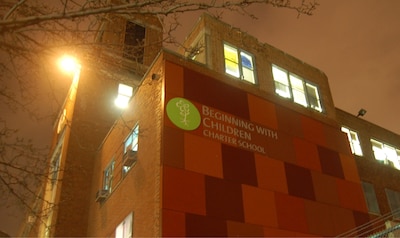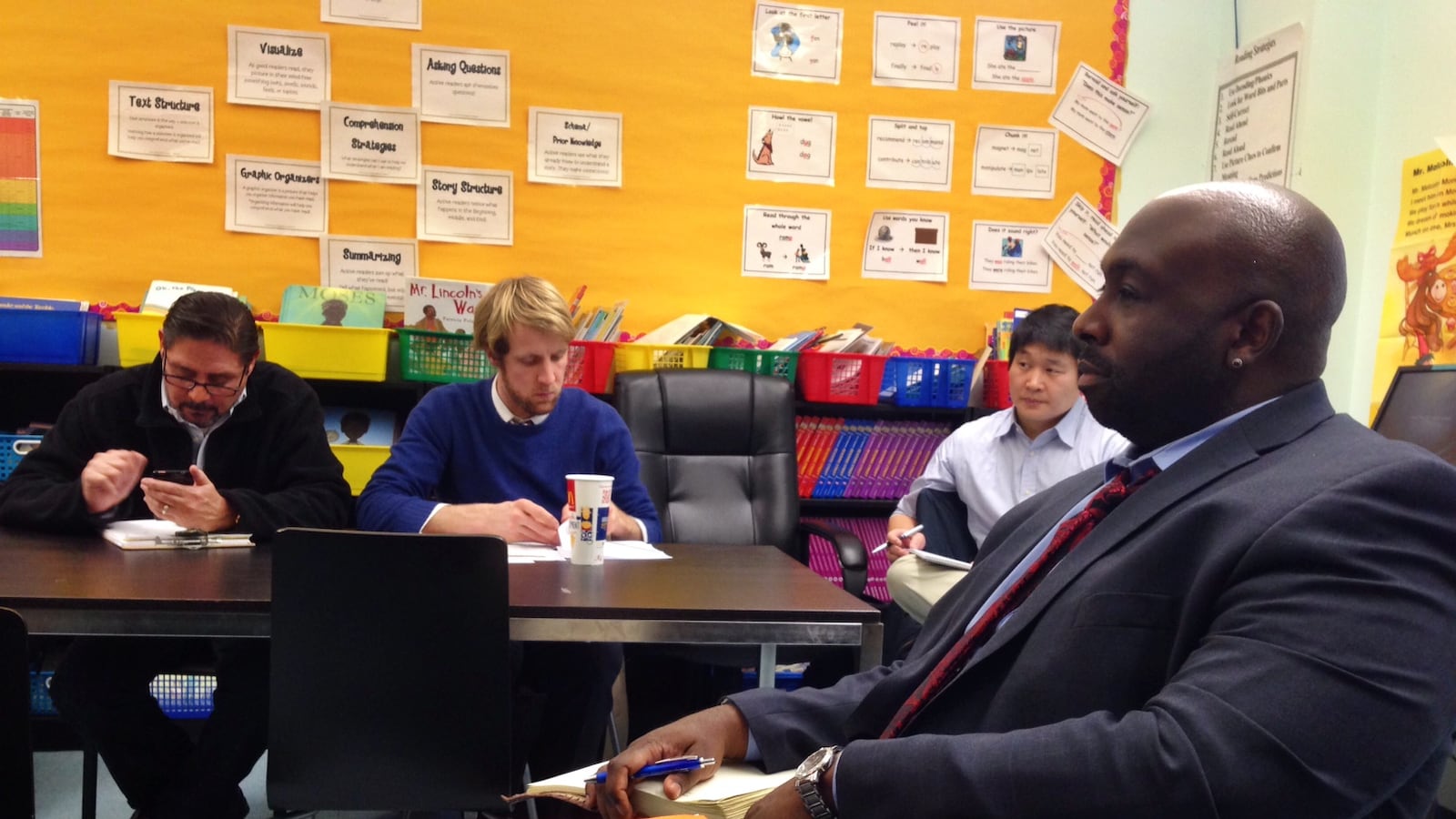As the Beginning with Children Charter School board meeting entered its third hour, the remaining parents in the middle school auditorium in Williamsburg were fidgeting in their seats. Recently told the school would be closing at the end of the year, parents had come looking for clarity, but gotten little of it.
Ellen Eagen, a Syracuse-based lawyer who specializes in education law, then walked to the front of the room and begged for a few more minutes of their time. “It’s time to roll up our sleeves and keep the school open,” she told the parents, before asking for volunteers to join a group crafting a plan for the school’s future.
Eagen isn’t a member of the school’s board of trustees, its charter management organization, or its authorizer. She became involved with the school just months ago when its board took the unprecedented step of voting to give up its right to operate—even though its charter extended for another two years.
Now, Eagen and an ad hoc group of parents, teachers, and board members who have reversed course are attempting to keep the school open independently, though they face long odds.
It’s a strange turn of events for a school that helped pave the way for New York’s charter school movement, which operates from the idea that its accountability systems guarantee high-quality schools: if a school doesn’t perform well, it gets closed.
At Beginning with Children, a fight over the teachers’ union contracts has overshadowed that process. Now, disagreements about whether the school is struggling, who is to blame for its problems, and if it is beyond repair have embroiled teachers, parents, board members, and a foundation in a tug of war that will determine the fate of the school.
A nontraditional start
Beginning with Children Charter School is unlike most of the city’s charter schools, which are relatively new and whose teachers are not unionized. But it also serves as a symbol of the origins of New York charter schools.
The school was opened in 1992 by Joseph and Carol Reich, philanthropists who became interested in public education in the late 1980s. Long before charter schools were allowed to operate in New York state, the Reichs pushed Brooklyn’s District 14 leaders to allow them to open their own public school with many of the freedoms now associated with charter schools.
The school they started transitioned from a charter-like school to a full-fledged charter school in 2001, but the school’s teachers remained members of the city teachers union in keeping with state law. That made it one of just seven New York City charter schools born from district schools, of which only five remain.
When its middle school opened on one floor of a nearby city school building, Beginning with Children also became a pioneer of co-location, which the Bloomberg administration later embraced as a way to help the charter sector expand.
In their book “Getting to Bartlett Street,” the Reichs note that other community groups came looking for help developing their own schools after the school was designated the city’s most-improved elementary school in 1997.
But they said they had not gotten everything right. By converting from a district school rather than starting a new charter school, Beginning with Children committed to upholding the city’s contract with the teachers union and paying the city’s portion of teachers’ health care and pension plans from the school’s budget. This was “an expensive mistake,” the Reichs wrote, and a decision now shaping the future of Beginning with Children.
Evaluating Beginning with Children
A charter school’s most important assessments come from its authorizer, which decides whether the school’s performance justifies its continued existence. For Beginning with Children, the authorizer is the city Department of Education, whose last assessment in April 2011 noted that the school had community support, its students were making adequate academic progress, its board was functioning effectively, and recent revenues exceeded expenses. That judgment earned the school approval to operate until June 2016.

But in recent months, other stakeholders at Beginning with Children have asserted that the school’s situation is dire enough to require dramatic, immediate change—and have attempted to make it happen themselves.
Representatives from the Beginning with Children Foundation, which has helped manage the school for more than 20 years, informed the school months ago that it would pull out from its role as a charter management organization unless the school’s teachers adopted a “thin contract.” (That Green Dot-style contract eliminates many work rules, including tenure and seniority-based layoffs.)
The school’s academic performance shows that it has failed in its mission, they said, and new contracts would allow for a longer school day and other shifts they say would improve instruction.
Parts of the foundation’s assessment are borne out by state test scores. Only 18.8 percent of students passed last year’s state English exam, and 14.9 percent passed the math exam, compared to city averages of 26.4 percent and 29.6 percent. Its students also scored lower than their peers in District 14, critical comparison points for charter schools.
The city’s last annual review also noted that only 6.3 percent of the school’s students were English Language Learners, compared to a 11.4 percent district average—the third year in a row that Beginning with Children served fewer high-needs students than their neighbors did.
But the school earned Bs on its last two city progress reports, boosted by data showing its students improved more than at most of its peer schools, and a number of parents and teachers say they’re seeing academic improvement. The idea that the school should close because of its academic challenges doesn’t add up, teachers said, especially when they’ve been changing the curriculum, doing intensive new professional development, and integrating the Common Core simultaneously over the last three years.
“We don’t understand—we’re a B school,” science teacher Jazmin Rivera said. “We have two more years until the charter is up. Schools close when they’re failing. We’re not there.”
Foundation spokesman Bob Bellafiore said the decision to pull out was simply a result of the determination that the school was not providing a better education than other area schools.
“Charters have to perform. And this is proof of what happens if a school doesn’t perform,” Bellafiore said. “It’s a story of a school not succeeding, but an educational reform succeeding.”
Inside the school, teachers and parents say the back and forth over the school’s status have made it even more difficult to focus on improving scores. Twelve seventh-graders have already left the school, according to middle school principal Dionne Jaggon, presumably to attend a school they know will be open next year. For teachers, the potential closure, intense pressure to improve academics, and recent clashes with school leadership have created a pressure-cooker environment.
“We’re just trying to make sense of all of this. You have new curriculum, new visions. It’s difficult to adapt to all of that, and a lot of teachers left,” Rivera said.
Anatomy of a power struggle
The tug of war over the school’s closure has emerged from the competing groups that influence the school’s operations.
For Beginning with Children Charter School, the foundation that shares its name has played the most significant management role. It has provided academic support, an alumni program, and help supervising the school’s finances and infrastructure. Crucially, the foundation has also provided the school with its space at 11 Bartlett St.
Meanwhile, as required by law, the school’s board of trustees has chosen the school’s leaders, set its budgets, and made other governance decisions. By November, Beginning with Children’s board conceded it couldn’t support the school on its own and that it had been unable to recruit a new charter management organization.
So, faced with potentially running a school with no foundation backing, no space, and just a handful of board members, the board voted to dissolve the school at the end of the year.
Asenhat Gomez, a parent of seventh and an eighth grader at the school, said the decision left parents reeling. “It’s very weird and very sad,” she said.
“At this point it’s like, who do we trust?” Gomez asked.
The United Federation of Teachers’ general counsel Adam Ross said the union sees the discussion about school quality as a distraction. “Despite the largely successful nature of the school and the improving nature of the school,” he said the foundation and the school’s board “elected to close the school out of what largely seems to be largely anti-union animus.”
Stacey Gauthier is principal of one of the only other conversion charter schools in the city, Renaissance Charter School, and knows firsthand the special difficulties facing those schools. “We don’t like everything that’s on the contract and we try to work around certain issues,” she said. But she added that it would be hard for her to imagine her school’s management coming to the same ultimatum. “Would we make the decision to say, ‘If you don’t do this …’? I think that’s drastic.”
Bellafiore said that without the requested teacher contract changes, the foundation stands behind its decision to walk away. “Its resources would be better applied elsewhere to better fulfill the mission,” he said.
Plans for a fresh start
The foundation’s next focus looks like it will be a brand-new charter school. The foundation was involved in planning a new school for much of last year with many of the characteristics of Beginning with Children Charter School, though without its union affiliation.
According to the proposal, which was submitted to SUNY’s Charter Schools Institute but withdrawn last October, the school would have operated in Brooklyn and eventually served grades K-8, potentially drawing from South Williamsburg and other neighborhoods close to Beginning with Children.
The proposed school would have had the extended-day program, Saturday academic help, and other programs that the foundation pushed for at Beginning with Children and are already in place at another charter school managed by the foundation. (That school, Community Partnership Charter School, has higher proficiency rates than Beginning with Children but earned a D on its last city progress report after three years of higher grades.)
That application also shows that foundation officials were acknowledging Beginning with Children’s potential closure months before the board’s vote. If public space were unavailable for the new school, the building could be sublet to the new school for $1 per year, the application notes.
Bellafiore said the charter was withdrawn because the foundation wanted to wait for the Beginning with Children Charter School’s situation “to clarify itself.” The foundation has not yet decided whether the school will be able to use 11 Bartlett St.—the space that proved central to the school’s creation two decades ago—if it finds a way to remain open, he said, though it has committed to providing its alumni program to former students.
The Reichs declined to be interviewed, saying through a spokesperson, “Our heart is still with the community we worked with for so many years. While we have great hope for a better tomorrow for the children, we have not been involved with the school for the last four years.”
The board’s next steps
Knowing that the school won’t have the support of the Beginning with Children Foundation or another management organization, the charter school’s board members have now embarked on an experiment: trying to find a path forward on their own.

Eagen, who previously sued the city on behalf of Williamsburg Charter High School, is now representing the school’s parents and teachers pro bono. Before the December meeting, she found people willing to join the school’s anemic board, including a Beginning with Children graduate, a local middle school principal, and a real estate broker.
That meeting started with brief, awkward interviews of the new board candidates on stage in front of an auditorium full of parents. (“I’d be lying if I said I knew much,” one candidate said of his ideas to turn the school around.) Hours later, the board voted to bring on the new members and pushed the deadline for a decision about the school’s future until the end of January.
That has put the responsibility for the school’s future on an entity that has also faced major internal and external pressures in recent years. In 2007, unhappy with what they described as chaotic infighting among board members, the Reichs came out of retirement and threatened to withdraw support from the school unless the board restructured. It did, but not without a very public fight.
By last year, Beginning with Children Charter School was operating with a nearly nonexistent board, even as the foundation recruited six people to serve on the founding board of its potential new charter school.
Longtime board member John Day had resigned by last summer, leaving Beginning with Children Charter School’s board with four members (down from 11 in 2011), according to meeting minutes. Four board members is well below the recommendations of the New York City Charter Schools Center, whose guide to building a charter school board suggests 11 to 21 members. It’s also lower than the minimum number allowed by the school’s charter, which is five.
That is probably why Day, the board’s most recent departure, voted at the November meeting when the board decided to return the school’s charter to the Department of Education.
Bellafiore, the spokesman for the board and the foundation, explained Day’s voting in two ways: that his earlier resignation was not effective, and that he had become a member of the board again before he took the vote. Day did not respond to requests for comment.
Moving ahead
In a third-floor classroom at 11 Bartlett St. on this Monday night, 18 adults huddled around tables trying to figure out how to build a new version of Beginning with Children. The ad hoc committee members asked one another, how much space do we need? Why are our test scores so low? Are we making any progress?
After a teacher rattled off a long list of the school’s academic programs, board member Alex Fong was stumped.
“Why is it that we sounds like we have such a robust program and such a great school and at the same time, we haven’t been able to turn the students around?” he asked.
Without the structured support and experience of the foundation or another charter management organization, the committee grappled with basic questions. Jaggon asked if they should consider eliminating grade levels. New board member Jeffrey Unger said that it was nearly impossible to plan without a decision from the foundation about whether the school could continue to occupy 11 Bartlett St. And board members contemplated whether it was worth it to try to come up with a plan that might not be sustainable long-term.
The committee has set a deadline of the Jan. 30 board meeting to develop a plan for the school’s independent future, or to announce (again) that it will give up the school’s charter.
If the board decides to give up the charter, even that plan of action isn’t well-defined. The major players say they aren’t yet sure what would happen after that decision is made, given that charters are typically not given up voluntarily before they expire and conversion charter schools are so rare.
According to Ross, the union’s legal team is reviewing the contract to determine how teachers who were hired after the school’s conversion will be handled by the Department of Education. Bellafiore said the foundation was looking into whether it would have financial obligations to the school’s teachers after the charter was returned. And Eagen said she wasn’t yet sure what the full process of returning the charter even is.
Still, parents with children attending Beginning with Children face even greater uncertainty.
Many hadn’t worried about the rumors that the school’s board would give back its charter because board members had told them that the city was considering creating a district school from Beginning with Children’s teachers and students. In November, the board told parents that option was off the table.
Jazmin Andujar, a parent with three sons at Beginning for Children, said she’s hopeful that a clear decision will be made soon. She has been committed to the school since pulling her oldest son out of first grade at a district school in 2006 when he got a spot in Beginning for Children.
He’s now in sixth grade, and Andujar’s two younger sons have joined him, now in kindergarten and fourth grade.”It’s kind of a legacy with them,” Andujar said of her sons. “Of course I’m worried.”
At the committee meeting, Gomez, whose daughters attend the middle school, urged the group to take parents’ concerns seriously.
“Something needs to be said, and said soon,” she said.

